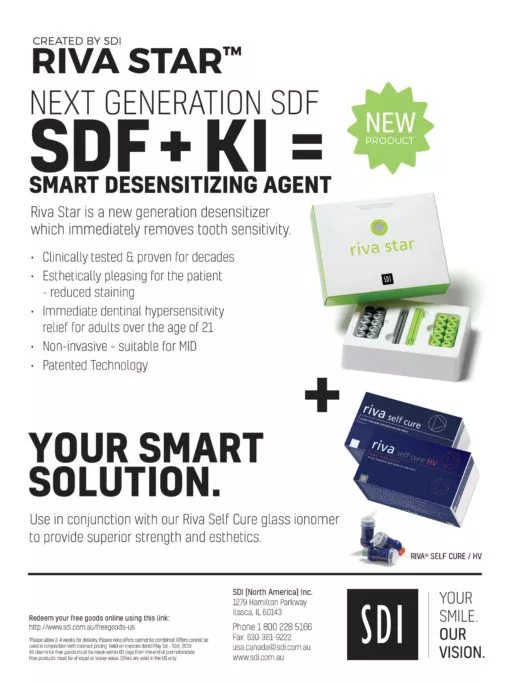 The concept of using amputation to treat an infectious disease was last used by the medical profession to treat gangrene in the late 1800s. The pharmacological management of dental caries aims to leave most caries in place, killing the bacteria and enabling infected dentin to heal as arrested caries. A way of achieving this is by using Silver Diamine Fluoride (SDF) that has been available to dentists for over 50 years. Whilst SDF it is currently receiving a resurgence in interest, this procedure has never gained real traction in general dentistry, due to the staining associated with it.
The concept of using amputation to treat an infectious disease was last used by the medical profession to treat gangrene in the late 1800s. The pharmacological management of dental caries aims to leave most caries in place, killing the bacteria and enabling infected dentin to heal as arrested caries. A way of achieving this is by using Silver Diamine Fluoride (SDF) that has been available to dentists for over 50 years. Whilst SDF it is currently receiving a resurgence in interest, this procedure has never gained real traction in general dentistry, due to the staining associated with it.
Riva Star (SDI, Australia) combines the application of SDF followed by potassium iodide (KI) to dental caries that prevents staining by scavenging free silver ions. This prevents silver flocculation onto dentin and forms silver iodide, a creamy white precipitate.
Riva Star is suitable for application from hypersensitive to any asymptomatic carious lesion in both deciduous and permanent teeth. If used in conjunction with a self-cure GIC (providing the correct treatment protocol is followed), it will arrest caries and assist with the remineralization of the lesion to become a caries resistant base under the restoration. Applied correctly, it will neither stain surrounding tooth structures or the restoration. As a precaution however, clinicians are advised to avoid restorations within the aesthetic zone until they have mastered this treatment protocol. The higher the pH of an SDF solution the further it may penetrate into carious dentin and precipitate out more dissolved tooth mineral within the caries. Application of KI to the SDF reduces the pH in the dentinal tubules to around pH 9.
Caries Access
Accessing caries is required, especially proximally, for the correct application of Riva Star. Depending upon patient compliance, local anaesthetic is usually unnecessary. Occlusal caries requires minimal tooth removal. Proximal caries may require using an ultra-conservative “tunnel preparation” for permanent teeth or for deciduous teeth, a small proximal slot preparation.
Riva Star Application
Any clinician who has used SDF from a multiple dose bottle will be aware of the problems of staining on operatory surfaces associated with this delivery system. Furthermore, ammonia continually leaks from the container every time the cap is removed reducing the clinical effectiveness of the SDF. A single dose delivery system reduces cross contamination and minimizes staining of operatory surfaces.
Clinical Steps to Riva Star
- Isolate the preparation
- Etch the preparation for 15 seconds, wash and dry
- Take the SDF (grey) vial and break the seal with the hard end of the brush applicator
- Apply the SDF with the brush over the caries
- Immediately following this, similarly, apply the KI (green) vial over the SDF
- A white precipitate will appear
- Continue applying the KI solution until the white precipitate completely disappears
- Wash away the reactant with water and dry the preparation
This will remove free silver ions and any residual AgI that may break down and potentially stain the surface. Remaining AgI, seen as a white film on the caries, is bound to collagen protein that is extremely stable and unlikely to break down over time.
GIC and Composite Placement
A self-cure GIC restoration is indicated immediately after SDF/KI treatment. If the restoration encroaches upon undermined cusps in the tooth or has a large load bearing area, a GIC and composite resin “co-cure” sandwich restoration is indicated.
Conclusions
The pharmacological management of dental caries is a new era in the science of restorative dentistry. Patients can expect significant reduction in the time and discomfort associated with a dental visit. Dentists who engage in pharmacological caries management and use biomimetic restorative materials that assist the tooth’s own ability to heal, see dramatic improvements in clinical efficiency and patient acceptance of care.



